Effects of Cattle Grazing on Survival and Growth of Valley Oak Seedlings  2000
2000
Phytosphere Research, Vacaville, CA
Abstract: In 1989, valley oak acorns were planted at three locations in northern California on oak woodland used as rangeland. Cultural inputs employed at planting included protective caging of individual planting sites, cattle exclusion, mulching, tillage, and first-year irrigation. In this paper we examine seedling growth and survival through 1997 or 1999, depending on the location. Survival ranged from more than 80 percent in the best treatment/site combination to zero in the worst, and maximum seedling height was over 360 cm (11.8 ft). Protection from cattle was essential for seedling growth and survival in grazed fields. Seedling survival and growth in individually caged planting sites was greater in grazed fields than in adjacent nongrazed fields. Landscape fabric and wood chip mulches applied at planting favored seedling growth and/or survival. Natural juvenile oaks protected with individual cages on a grazed valley floor grew on average 21 cm per year, whereas nonprotected juveniles made no height growth.
Valley oak, Quercus lobata Nee, is endemic to California. This deciduous oak was once widely distributed in riparian forests, valleys, and foothills and ranged from the Santa Monica mountains of southern California to the extreme northern end of the Sacramento Valley. Because valley oaks were commonly found on deep loamy soil favored for agriculture and urban development, this species is now reduced to a small remnant of its former population.
Due to increased interest in conserving and restoring valley oak woodlands, Q. lobata has been included in many California oak planting projects. This species is relatively easy to propagate, particularly if intensive cultural inputs are used during the establishment phase. However, intensive inputs may be prohibitively expensive for large-scale plantings intended to restock formerly wooded areas that are now used as rangelands. Furthermore, in at least some areas, the use of intensive inputs may not be necessary or cost-effective. If large amounts of valley oak woodland are to be restored, it will be necessary to minimize the restoration cost per unit area. This can be accomplished by identifying and using only those cultural inputs that are needed to successfully restock a given target area.
In 1989, we reviewed the literature and evaluated previous valley oak plantings to identify factors that could affect the establishment of valley oak seedlings (Swiecki and Bernhardt 1991). Using this information, we designed demonstration projects for three locations in northern California. For each project site, we determined what factors were most likely to limit seedling establishment and growth. We then selected restocking methods for each project that represented varying levels of cultural inputs, starting with the minimum inputs deemed necessary to establish seedlings. The combinations of inputs tested in each planting differ because different conditions existed at each location.
We previously reported on survival and growth at these projects 9 months (Bernhardt and Swiecki 1991), 18 months (Swiecki and Bernhardt 1991) and 6 years after planting (Bernhardt and Swiecki 1997). This paper is an update of Bernhardt and Swiecki (1997) which includes results from these projects after 8 to 10 growing seasons. A fourth demonstration project site, at The Nature Conservancy's Cosumnes River Preserve, was included in the original study (Bernhardt and Swiecki 1991, Swiecki and Bernhardt 1991). We do not include follow-up data on the Cosumnes project in this paper because it differs substantially from the projects at the other three locations.
METHODS
We established the demonstration plantings at three sites: the California Academy of Science's Pepperwood Ranch Natural Preserve in the North Coast Ranges of Sonoma County; the Napa County Land Trust's Wantrup Wildlife Sanctuary in Pope Valley; and the City of Vacaville's Hidden Valley Open Space reserve in Solano County. All three locations have been used for livestock grazing for a number of years. Elevations of the three locations are 250 feet for Vacaville, 650 feet for Wantrup, and 1000 feet for Pepperwood. Historical average annual rainfall is 25 inches for Vacaville, 30 to 35 inches for Wantrup, and an estimated 40 inches for Pepperwood. A drought reduced rainfall during the first 2 years after planting by 30 to 50 percent, depending on the location. The areas selected for restocking were open, grassy fields that had historically supported valley oaks. All fields had at least some scattered valley oaks at their edges or nearby. There was no significant shrub cover within any of the fields. harding grass (Phalaris aquatica L.) was prevalent at the Pepperwood and Wantrup sites. We have previously reported detailed descriptions of the study sites (Bernhardt and Swiecki 1991, Swiecki and Bernhardt 1991).
General Methods
At all locations, volunteers planted locally-collected acorns in late October or early November 1989. For most treatments, planting sites were prepared by using a shovel to turn over and break up the soil. At each planting site, four apparently viable acorns were planted on their sides at a depth of about 5 cm, spaced 15 cm apart in a square pattern. At Wantrup, soil was not turned over before planting, and acorns were inserted into cracks in the soil opened up with a shovel.
In grazed fields, we used cages constructed of welded, 5- by 10-cm mesh galvanized 12-gauge wire fencing to protect seedlings from browsing by both cattle and deer (Vaca cages). Each Vaca cage was secured on one side by a steel T-post and on the opposite side by a 86-cm length of 9.5-mm diameter steel reinforcing bar (rebar), which was driven into the soil at least 30 cm. In nongrazed areas, we used cages constructed of lightweight 2.5-cm diameter wire mesh (poultry netting) to prevent deer browsing (deer cages). Deer cages were secured by a 150-cm length of rebar or a T-post on one side and a 60-cm length of rebar on the opposite side. Both Vaca and deer cages were 122 cm tall and about 45 cm in diameter.
We used 90-cm squares of nonwoven polypropylene landscape fabric (Typar®, Reemay, Inc.) as a mulch in some treatments. We cut two slits about 30 cm long in an "X" pattern in the center of each fabric square to permit emergence of oak seedlings and fastened the fabric to the ground with a 10-cm long steel staple in each corner. Because Typar® fabric breaks down when exposed to sunlight, we covered it with a 5- to 7-cm thick layer of organic mulch (waste wood chips), following the manufacturer's recommendations. Other materials used for mulch included a 5- to 7-cm thick layer of waste wood chips and a 7- to 10-cm thick layer of old, moldy oat hay.
We collected data on seedling survival and height several times during the first two growing seasons and annually or less frequently between 1992 and 1997. Survival percentages we report are based on the total number of planting sites. Average heights reported are those of the tallest live seedling at each planting site, and height analyses exclude sites without live seedlings. We used contingency table analysis and logistic regression to analyze the effects of treatments on seedling survival, and analysis of variance to analyze the effects of treatments on seedling heights. Differences and effects reported as significant are significant at P 7 0.05, unless otherwise noted.
Vacaville
The Vacaville project site is an urban open-space buffer between housing developments within the City of Vacaville and consists of two adjacent south-facing hillsides of about 2.8 ha ( 7 acres) each. Both hillsides are grazed by cattle at variable stocking rates that average about 2.5 animals/ha. Grazing periods have varied as shown below over the period 1990 to 1995. Since 1995, grazing periods have generally been later (spring/ summer), but we do not have information on the exact grazing periods after 1995.
|
Grazing season |
||
|
Year: |
West hill |
East hill |
|
1990 |
1 April - mid-May |
late March - late April |
|
1991 |
May to mid-July |
mid-March - late April |
|
1992 |
December 1991 - late June |
December 1991 - late June |
|
1993 |
mid-March - late April |
no grazing |
|
1994 |
early January - late June |
early April - late June |
|
1995 |
December 1994 - late July |
December 1994 - late June |
We anticipated that damage by cattle, moisture stress due to weed competition, soil depth and compaction, and vandalism would be the most likely factors to limit restocking success at this site. To protect seedlings from cattle, we installed Vaca cages on all but a single treatment. We marked noncaged sites with metal tags pinned to the soil with 110-cm nails and used a metal detector and distance and azimuth readings from known reference points to relocate the sites.
We used landscape fabric mulch in two treatments, and the remaining treatments received a thin mulch of dry grass. For one treatment, we used a two-person power soil auger with a 10-cm diameter bit to loosen the soil to a depth of 45 to 60 cm. For two other treatments, we probed the soil at potential planting sites with a 6-mm diameter steel rod in an attempt to differentiate between shallow/compacted sites and deep/noncompacted sites. We combined these cultural inputs to construct the following five planting treatments and planted 30 planting sites per treatment on each hillside:
|
Treatment: |
Cultural inputs |
|
V1 |
No cage, grass mulch, probe to depth of 45-60 cm |
|
V2 |
Vaca cage, grass mulch, probe to depth of 45-60 cm |
|
V3 |
Vaca cage, grass mulch, probe to depth of 30 cm |
|
V4 |
Vaca cage, landscape fabric, wood chip mulch |
|
V5 |
Vaca cage, landscape fabric, wood chip mulch, auger to depth of 45-60 cm |
Pepperwood
The planting locations at Pepperwood are two adjacent hillside fields, one currently grazed by cattle and the other nongrazed. For the first several years after planting, cattle had access to the grazed field from late October to mid-May, and there was little residual herbaceous cover at the end of this period. Since 1992, the grazed field has been stocked at 2.5 animals/ha, and grazed for 1 to 3 weeks in late spring or early summer.
We anticipated that browsing by cattle and deer and water stress due to shallow soils and weed competition would be the major factors limiting restocking. We protected all sites with cages, using deer cages in the nongrazed field and Vaca cages in the grazed field.
To cope with the limitation of soil depth and make the best use of available soil moisture, we avoided areas with extremely shallow soil and concentrated our planting sites near seeps and seasonal creeks present in the fields. We planted 40 to 41 sites per treatment in the grazed field, and 24 to 33 sites per treatment in the nongrazed field. The treatments were:
|
Treatment: |
Cultural inputs |
|
P1 |
No mulch (both fields) |
|
P2 |
Wood chip mulch only (both fields) |
|
P3 |
Landscape fabric mulch (both fields) |
|
P4 |
Landscape fabric mulch, first summer irrigation (nongrazed field only) |
Sites in the irrigated treatment received approximately 40 L of water per irrigation through 4-L/h drip emitters once a month, beginning 1 June 1990 and ending 1 September 1990.
Wantrup
The Wantrup Wildlife Sanctuary planting sites are located in three adjacent fields on the nearly level floor of Pope Valley. Field 1 is a 40.5-ha pasture that has been grazed for many years, and since 1989, it has been stocked with about 15 cow-calf pairs from December through June. There is little residual herbaceous cover after seasonal grazing, except for patches of yellow star thistle (Centaurea solstitialis L.). Field 2 is an area adjacent to a seasonal creek which was fenced to exclude cattle in about 1984. Field 3 had been grazed less heavily than field 1 for several years before planting, and grazing was discontinued after planting. Eight planting sites that had live seedlings in October 1994 were destroyed in summer 1995 when field 3 was tilled.
We expected that browsing by deer and/or cattle, moisture stress due to weed competition, damage by ground squirrels in the grazed field, and gophers in field 3 would limit restocking at this location. We used Vaca cages in the grazed field and deer cages in the remaining fields to protect seedlings from browsing. We avoided areas of high rodent activity for most plantings, but some planting sites in field 1 were intentionally located near an active ground squirrel colony for comparative purposes.
We tested several cultural inputs to reduce weed competition and conserve soil moisture. In each field, a strip about 4 m wide was tilled with a disc in September 1989 to remove weeds. We planted sites in both the tilled areas and in adjacent nontilled areas in each field. Every other site was mulched with hay at the time of planting.
In the nontilled portion of field 3, we also tested hay-mulched and nonmulched drip irrigation treatments. During 1990 only, irrigated sites received 20 L of water once weekly, starting 13 May and ending September 17.
We also tested herbicide application as a weed-control treatment in the nontilled portion of field 2. Glyphosate was applied at full label rate in a 150-cm radius around each planting site 1 month before planting and again about 1.5 months after planting. The post-planting application occurred several months before oak seedling emergence. No mulch was used in the herbicide treatment.
We used a 3 by 2 by 2 factorial design for the bulk of the planting: three fields with nontilled/tilled and nonmulched/mulched treatments in each. Irrigated (mulched and nonmulched) and herbicide treatments were treated as three separate treatments in addition to the 12 factorial treatment combinations. We planted 20 sites for each treatment.
At Wantrup, we also set up a separate study in field 1 involving existing natural juvenile valley oak seedlings and saplings, all of which were heavily browsed. Initial heights of these oaks ranged from 10 to 52 cm and averaged 35 cm. On 6 June 1989, we set up several types of protective cages around 22 juvenile oaks in the grazed portion of the field and four within a 0.5-ha barbed wire exclosure that excludes cattle but not deer. The cages were originally of varying heights, but all were eventually upgraded to a height of at least 120 cm. Using distance and azimuth measurements to known reference points, we charted the positions of 20 additional oaks in the grazed area and six in the exclosure. These noncaged oaks were located among and were similar in height and condition to the caged oaks. We measured the heights of the caged and noncaged oaks on 6 June 1989 and periodically thereafter.
RESULTS
Seedling Survival
At Vacaville, 97 percent of the planting sites had at least one live seedling emerge during the first season after planting, and there were no significant differences in emergence between treatments and hillsides. By July 1999, survival was significantly affected only by the use of Vaca cages (Figure 1 below). Survival of noncaged seedlings was significantly lower than that of caged seedlings beginning the second year after planting, indicating that seedlings emerged well, but survival was adversely affected by the browsing and trampling damage inflicted by cattle. The largest single-year decline in survival of noncaged seedlings occurred between the 1991 and 1992 growing seasons. Noncaged sites had few live seedlings after the extended 1992 grazing season. However, some of the browsed-off seedlings resprouted and were observed in 1993, during which one field was grazed lightly and the other was not grazed. By 1999, all of the noncaged seedlings had died. Mortality among caged sites includes four sites that have been lost due to the removal of Vaca cages by vandals.Figure 1. Survival by treatment of planting sites at Vacaville.
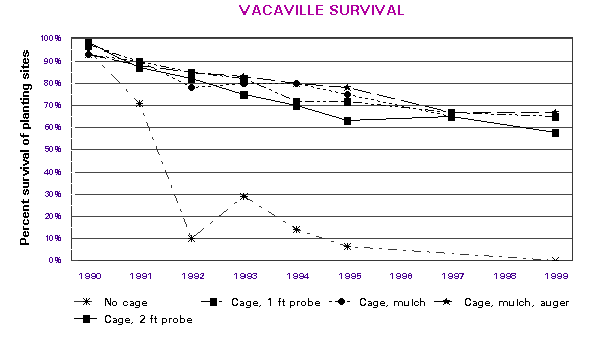
Initial emergence at Pepperwood was considerably lower than at Vacaville, with 81 percent of the planting sites containing at least one live seedling the first season after planting (Figure 2 below). Emergence differed significantly between planting treatments and fields. Overall emergence was greater in the grazed field than in the nongrazed field and greatest in the wood chip mulch treatment and lowest in the nonmulched treatment. Survival through 1997 was significantly affected by both field and treatment, but logistic regression analysis showed no significant interaction between these variables. Most treatments showed a sharp drop in survival between June 1991 and June 1992. By 1997, the overall survival rate of caged planting sites in the grazed field (60 percent) was significantly greater than in the nongrazed field (34 percent). Seedling damage attributed mainly to voles has been common in the nongrazed field, which is covered with a very dense and tall (100-180 cm) stand of harding grass. In the grazed field, cattle have kept growth of harding grass and other weedy herbaceous vegetation in check, and there has been little rodent damage. Within each field, seedling survival was significantly greater in mulched treatments than in nonmulched treatments. First-year irrigation, tested only within the nongrazed field, did not affect seedling survival.
Figure 2. Survival by treatment and field (grazed, nongrazed) of protected planting sites at Pepperwood.
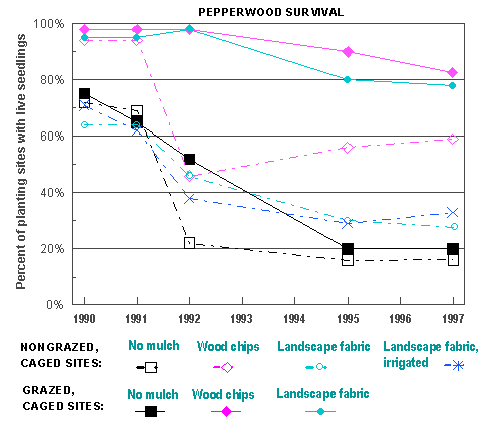
At Wantrup, first season emergence was almost identical to that at Pepperwood, with 82 percent of planting sites containing at least one live seeding the first season after planting. There were no significant differences in emergence between fields. Seedling emergence was significantly lower among sites mulched with moldy hay mulch (77 percent) than among nonmulched sites (87 percent). We observed that in some sites, an excessively thick layer of compacted hay impeded seedling emergence. The hay mulch did not decompose at the rate we had anticipated because winter rainfall was below normal. Emergence was also significantly greater in tilled sites (92 percent) than in nontilled sites (71 percent).
By 1997, survival differed significantly between fields (Figure 3 below) and between tillage treatments, but was not affected by mulch, herbicide, or irrigation treatments. Survival of seedlings in caged sites in the grazed field (field 1) was greater than that in the nongrazed fields as early as 1992, and this difference was still significant in 1997. By 1995, both nongrazed fields had dense stands of harding grass, although the harding grass density in field 3 had been much lower at the start of the project. Seedling damage attributed to voles was common in the nongrazed fields, but rare in the grazed field.
Within the grazed field, seedling survival was significantly lower among sites located within 10 to 15 m of an active ground squirrel colony than among sites located farther away from the colony. By September 1995, 31 percent of the sites near the ground squirrel colony had live seedlings, compared to 65 percent survival for sites away from the colony. By 1997, twice as many planting sites in tilled strips had surviving seedlings (18 percent of planting sites) compared to those in nontilled areas (9 percent of planting sites). As at the other locations, the greatest increase in seedling mortality occurred between June 1991 and June 1992.
Figure 3. Survival by field (1 grazed, 2 nongrazed) of protected planting sites at Wantrup.
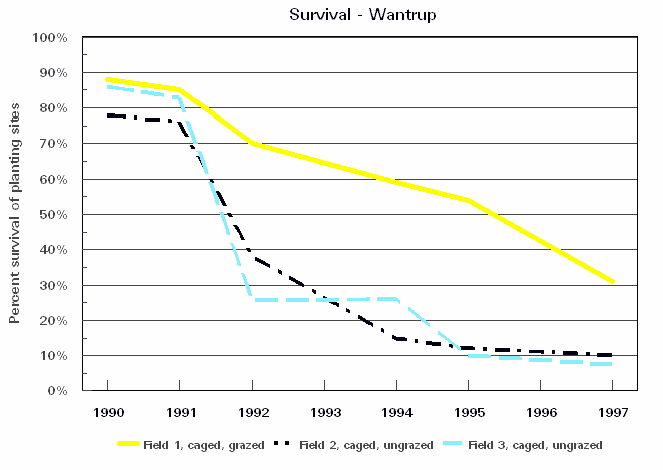
Seedling Growth
In the two-way analysis of variance of 1995 seedling heights for Vacaville (shown below), the effects of hillside and treatment were significant, but the interaction between these factors was nonsignificant. Seedlings on the east hillside were significantly taller than those on the west hillside. Much of this difference is due to rapid growth among a portion of the seedlings on the east hillside which are located on an alluvial fan. Valley oaks located in this area were much taller than seedlings on other parts of the hillside and ranged up to 288 cm tall in 1995 and over 360 cm in 1999. In addition, some of the seedlings on the west hillside were defoliated by grasshoppers in mid- to late summer of 1994 and 1995, but such damage has not occurred on the east hillside.
Figure 4. Average 1995 heights of tallest seedling per planting site by treatment and hillside at Vacaville.
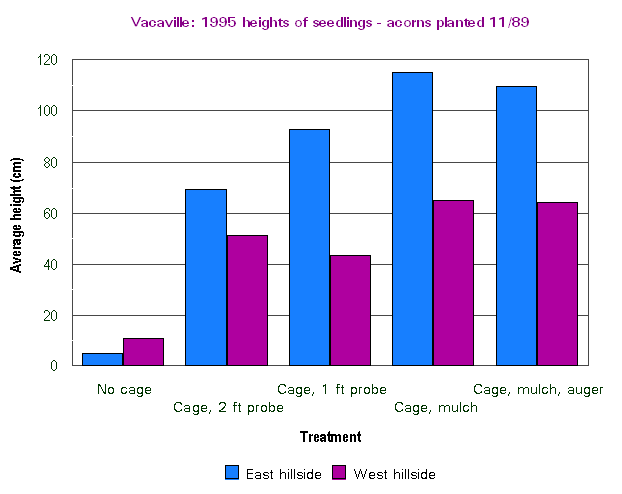
As shown in Figure 4 above, the surviving noncaged seedlings (only 4 plants) were significantly shorter than the surviving seedlings in Vaca cages in 1995. The average seeding height in the caged sites has increased steadily since planting, whereas the average height of the noncaged seedlings fell from 10 cm in 1990 to 6.5 cm in 1995. Based on orthogonal contrasts, seedlings in caged, mulched treatments (V4 and V5) were significantly taller than those in caged, nonmulched treatments (V2 and V3). All of these same factors and comparisons have been significant since the first height evaluation in August 1990.
Because seedlings were not thinned after planting, surviving planting sites have one to four seedlings. Average seedling height in 1995 was somewhat greater in sites with more than one seedling than in sites with a single seedling. However, the effect of seedling count per site was not significant in the analysis of seedling heights.In 1999, growth of seedlings on the west hillside continued to lag that on the east hillside (Figure 5, below). Substantial vole damage was noted for the first time in the history of the planting during the June 1999 census of the west hillside. Forty-seven percent of the surviving seedlings on the west hillside had been girdled by voles (presumably in 1998) and had resprouted from ground level. As noted above, there were no remaining noncaged seedlings by 1999.
Figure 5. Comparison of 1995 and 1999 heights of the tallest seedling in each protected planting site by hillside at Vacaville.
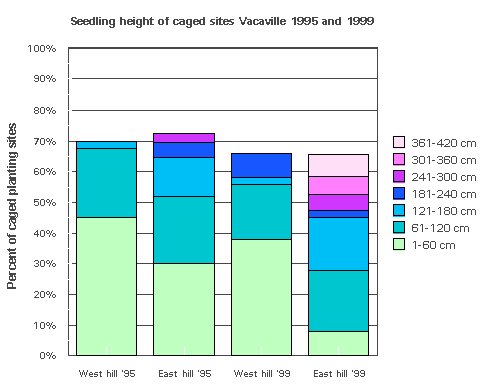
At Pepperwood, the average height of caged seedlings was significantly greater in the grazed field than in the nongrazed field in 1997 (Figure 6, below). This was true whether or not the irrigated treatment (P4), which was present only in the nongrazed field, was included in the two-way analysis of variance by treatment and field. The effect of treatment was not significant in either the two-way analysis or in one-way analysis of variance tests for each field. The lack of significance is due in part to the low numbers of surviving seedlings in several treatments.
At Wantrup, the effects of field was significant in a three-way analysis of variance comparing the effects of fields, tillage, and mulch on 1997 seedling heights. We omitted irrigated and herbicide treatments from these three-way analyses. Surviving seedlings in the grazed field, all of which were protected by Vaca cages, were significantly taller than seedlings in the two nongrazed fields (Figure 6, below).
Figure 6. Average 1997 heights of tallest seedling per planting site in grazed and nongrazed fields at Pepperwood and Wantrup. Seedlings in grazed fields were protected by Vaca cages; those in nongrazed fields were protected by deer cages.
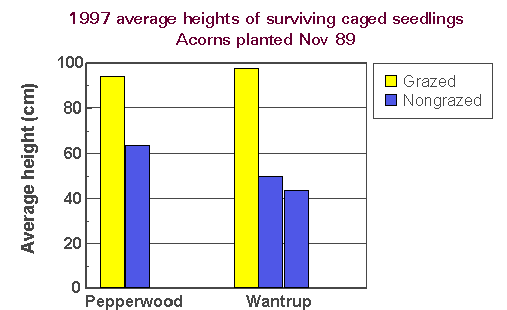
In 1995, we examined the effects of the herbicide and irrigation treatments on seedling height using one-way analysis of variance tests on data from individual fields. None of the within-field analyses showed any significant effects of treatment on seedling height. However, the number of surviving seedlings in most of these treatments was very small, so the power of these tests to detect differences was low. By 1997, the number of surviving seedlings in these treatments was too low to allow for a meaningful analysis.
Natural Juvenile Oaks (Wantrup)
During the 8 years in which we followed growth of protected and unprotected natural juvenile oaks, four of the noncaged juvenile oaks in the grazed area died, apparently because of browsing and trampling by cattle. Two noncaged and one caged oak within the cattle exclosure died over the same period, apparently because of girdling by gophers.
The average growth of caged and noncaged natural juvenile oaks between June 1989 and September 1997 is shown below in Figure 7. At the start of the experiment in 1989, the mean height of oaks assigned to the protected and nonprotected treatments were not significantly different (overall mean 35 cm). However, the effects of protection from cattle were obvious within the first two years. Within the grazed field, caged juvenile oaks grew significantly more than noncaged controls. All caged oaks within the grazed area gained height, with increases ranging from 67 to 288 cm by 1997. In contrast, ten of the 16 surviving noncaged oaks in the grazed area were shorter in 1997 than they were in 1989, and none of the noncaged oaks grew more than 35 cm. Within the cattle exclosure, growth of caged and noncaged juvenile oaks did not differ significantly, but the low sample size within the exclosure (7 surviving oaks in 1997) greatly limits the statistical power of our analysis. Juvenile oaks in the cattle exclosure grew less (Figure 7) and were significantly shorter than protected seedlings in the cattle grazed area, presumably because competition for soil moisture due to herbaceous vegetation was greater in the exclosure than in the grazed pasture.
Figure 7. Height growth of protected and nonprotected established natural juvenile oaks within a cattle-grazed field and a cattle exclosure at Wantrup.
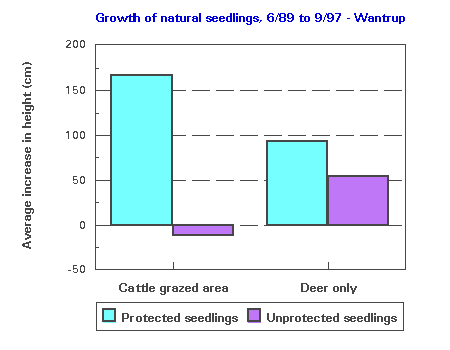
Cage Performance
Vaca cages used at each of the sites have required periodic maintenance because some of the cages are seriously bent or dislodged by cattle each year. In areas that receive especially heavy use by cattle, we have had to reinforce the cages by adding an additional T-post and/or longer and larger-diameter rebar stakes. At Vacaville, a number of T-posts and cages have been removed by vandals, but we have replaced the cages when we could relocate the seedlings. However, many of the original cages are still in service after 10 years. Deer cages used at Wantrup and Pepperwood were effective and did not require any maintenance.
DISCUSSION
Effects related to grazing
The demonstration projects clearly show that successful establishment and growth of valley oak is dependent upon protection from grazing cattle. Although first-year emergence did not differ significantly among treatments at Vacaville (Figure 1), survival and growth declined in the planting sites left unprotected from cattle. Most unprotected oak seedlings at Vacaville were killed by cattle browsing and trampling within a few years and all were destroyed within 10 years, even though cattle stocking at this site was generally moderate and limited in duration. Over seven growing seasons at Wantrup, established natural juvenile oaks grew substantially only if they were protected from cattle. Among the oaks at Wantrup that were exposed to cattle browsing, half either lost height or died between 1989 and 1997.
In grazed areas where sufficient numbers of existing oak seedlings or saplings can be located, protective caging may be the only input needed to recruit oaks to the tree stage. On the basis of the clear results of the demonstration projects, land managers at both Pepperwood and Wantrup have begun to protect individual natural seedlings from browsing to help restock degraded stands. The Vaca cage (Swiecki and Bernhardt 1991) has been fairly successful as a cattle-excluding structure. Vaca cages currently require about $8.00 to $10.00 worth of materials (if purchased new) and are fairly easy to construct, but do require periodic inspection and maintenance. Caging individual seedlings or planting sites is therefore somewhat intensive in terms of materials and labor, but this input is critical for restocking valley oak in fields grazed by cattle.
Cattle can inhibit natural or artificial regeneration by damaging or killing oak seedlings and saplings. However, by controlling the growth of herbaceous vegetation, grazing can indirectly favor growth and survival of caged oak seedlings that are protected from browsing. At Pepperwood and Wantrup, where all planting sites were individually protected from browsing, survival and growth of seedlings were significantly greater in grazed fields than in adjacent nongrazed fields. At both of these locations, the nongrazed fields are densely populated with harding grass, which competes with oak seedlings for soil moisture. Various researchers have shown that competing herbaceous vegetation can reduce survival and growth of oak seedlings (Adams and others 1991, Griffin 1971, Knudsen 1987). However, even in the presence of extremely competitive harding grass, oak seedlings were established under nongrazed nonirrigated conditions at both Pepperwood and Wantrup. Although reducing herbaceous competition promotes oak seedling establishment in many cases, complete control of competing vegetation is not necessary to establish valley oak in sites where soil moisture is not critically limiting.
The dense harding grass in the nongrazed fields at Pepperwood and Wantrup also provided habitat for voles and other rodents. Repeated clipping of seedling shoots and leaves by voles (Tecklin 1995), and possibly other small rodents, has apparently contributed to seedling mortality in the nongrazed fields. However, recent damage at the Vacaville site shows that voles may girdle established seedlings during some years even in grazed fields. Established oak seedlings are not necessarily killed when girdled by voles because young valley oaks resprout readily after loss of their shoots. However, destruction of the shoot can set back vertical height growth substantially and prolong the period that seedlings are highly susceptible to damage by livestock, rodents, and fire.
Moisture stress due to harding grass competition may have contributed to seedling mortality in the nongrazed fields at Pepperwood and Wantrup. Perennial grasses such as harding grass may compete more seriously with oaks than winter annual grasses because perennials continue to use soil moisture throughout much of the summer after winter annuals have died. Moisture stress can also exacerbate damage caused by voles or other agents. Because water-stressed oak seedlings grow slowly, they remain susceptible to small herbivores for an extended period and may have small carbohydrate reserves to draw upon for recovery after being damaged.
Effects of planting inputs
Mulch applied at planting is a relatively inexpensive, one-time input that can suppress weed growth and conserve soil moisture around planting sites. At Vacaville and Pepperwood, landscape fabric and/or wood chip mulches were beneficial in promoting seedling growth and survival (Figures 1, 2, and 4). The moldy hay mulch used at Wantrup did not provide any growth or survival benefit and was somewhat inhibitory to seedling emergence. As noted in the results, the straws were matted together and did not break down well because of low rainfall in the first winter. Within the nongrazed fields, the hay was also used by voles for nesting. Therefore, while mulch can be a beneficial input, improper materials or poor application may negate any potential benefits.
Tillage was the only other input that significantly affected seedling survival. Although the original intent of the tillage treatment was to control harding grass and other herbaceous weeds, tillage did not substantially reduce weed competition. We believe that the observed effects of the tillage treatment at Wantrup were largely due to the fact that seedbed conditions were improved by tillage. Wantrup was the only site at which tillage of the planting site was compared with an alternative planting technique, i.e., inserting acorns in small cracks in the soil opened up with a shovel. At both Vacaville and Pepperwood, all acorns were planted into soil that had been tilled with a shovel to prepare a suitable seedbed. Acorns planted in tilled soil would have been less exposed to drying than acorns planted into soil cracks. Tillage also relieves soil compaction caused by livestock, reducing the mechanical resistance of the soil that must be overcome by the germinating acorn's root and shoot. Preparation of a suitable seedbed is a simple input which is likely to enhance seedling establishment.
Irrigation during the first summer, which was an expensive input, did not significantly increase survival or growth of seedlings growing in nongrazed fields at Pepperwood and Wantrup. Based on field observations, these seedlings generally sustained greater damage from small herbivores than did nonirrigated seedlings. Damaging animals may be attracted to irrigated sites by the moist soil or increased succulence of oak tissues.
As expected, seedlings close to the ground squirrel colony at Wantrup had much lower survival rates than seedlings farther from the colony. Our strategy of locating planting sites away from active rodent burrows has been successful in minimizing damage caused by gophers and ground squirrels. This simple step may be sufficient to eliminate the need for more expensive inputs, such as additional caging or shelters, if gopher and ground squirrel populations are not excessive.
Overall survival and growth trends
At all locations, treatments with less than 60 percent survival by 1995 showed the largest drop in survival between the 1991 and 1992 growing seasons, or 2 years after planting (Figures 1-3). This may represent the point at which carbohydrate reserves derived from the acorn have been exhausted in seedlings that die back to the ground early during the first two growing seasons. Natural blue oak seedlings that died back to the ground in two successive years had higher mortality rates than seedlings that maintained above-ground shoots in one or both years (Swiecki and others 1990). The main reason that cattle grazing is so lethal to young oak seedlings is that the seedling shoot is subject to repeated destruction by browsing, which eventually depletes their limited carbohydrate reserves.
Although some of the trees in the Vacaville planting have grown well above browse line in 6 years, it will clearly be many years before most of the valley oaks in the demonstration projects are recruited to the tree stage. We only recently (February 2000) removed the protective cages from some of the largest oaks (8 - 10 cm diameter at 137 cm height) in the Vacaville planting. Overall growth rates for the plantings are fairly low, averaging between about 5 and 15 cm/year for caged seedlings. Even though the plantings were established during a prolonged drought, such low growth rates are probably typical for nonirrigated plantings that receive no continuing maintenance (such as weed control).
Although some of the survival and growth trends we observed in the first two growing seasons persisted for six or more years, other trends have appeared later and some early patterns have not persisted over the long term. For example, although the difference in growth between grazed and nongrazed fields was noticeable at Pepperwood the first year after planting, at Wantrup, seedlings in the grazed field were initially shorter than those in one of the nongrazed fields (Swiecki and Bernhardt 1991). The difference in survival now evident between grazed and nongrazed fields at Wantrup and Pepperwood did not develop within the first two seasons. Long-term monitoring of oak planting projects is necessary to determine which cultural inputs are the most worthwhile.
Acknowledgments
The first 2 years of this study were supported by Contract 8CA84965 from the California Department of Forestry and Fire Protection, Forest and Rangeland Resources Assessment Program. We gratefully acknowledge the important roles of land managers Joe Callizo, Wantrup Sanctuary, and Greg DeNevers, formerly at Pepperwood Preserve, in the establishment and maintenance of field plots and in data collection. We also thank Bob Farrington and Rollie Simons, City of Vacaville, for their assistance in establishing the Vacaville planting. We thank the many volunteers who have assisted in planting and maintaining the planting sites over the years.
References
Adams, Theodore E., Jr.; Sands, Peter B.; Weitkamp, William H.; McDougald, Neil K. 1991. Blue and valley oak seedling establishment on California's hardwood rangelands. In: Standiford, Richard B., tech. coord. Proceedings of the symposium on oak woodlands and hardwood rangeland management; October 31 - November 2, 1990; Davis, CA. Gen. Tech. Rep. PSW-126. Berkeley, CA: Pacific Southwest Research Station, Forest Service, U.S. Department of Agriculture; 41-47.
Bernhardt, Elizabeth A.; Swiecki, Tedmund J. 1991. Minimum input techniques for valley oak restocking. In: Standiford, Richard B., tech. coord. Proceedings of the symposium on oak woodlands and hardwood rangeland management; October 31 - November 2, 1990; Davis, CA. Gen. Tech. Rep. PSW-126. Berkeley, CA: Pacific Southwest Research Station, Forest Service, U.S. Department of Agriculture; 2-8.
Bernhardt, Elizabeth A.; Swiecki, Tedmund J. 1997. Effects of cultural inputs on survival and growth of direct seeded and naturally occurring valley oak seedlings on hardwood rangeland. In: Pillsbury, N.H.; Verner, J; Tietje, W. D., tech coords. Proceedings of the Symposium on Oak Woodlands: Ecology, Management, and Urban Interface Issues; 19-22 March 1996; San Luis Obispo, CA. Gen. Tech. Rep. PSW-GTR-160. Albany, CA: Pacific Southwest Research Station, Forest Service, U.S. Department of Agriculture; pages 301-311.Griffin, James R. 1971. Oak regeneration in the upper Carmel Valley, California. Ecology 52: 862-868.
Knudsen, Monty D. 1987. Life history aspects of Quercus lobata in a riparian community, Sacramento Valley, California. In: Plumb, Timothy R.; Pillsbury, Norman H. , tech. coords. Proceedings of the symposium on multiple-use management of California's hardwood resources; November 12-14, 1986; San Luis Obispo, CA. Gen. Tech. Rep. PSW-100. Berkeley, CA: Pacific Southwest Forest and Range Experiment Station, Forest Service, U.S. Department of Agriculture; 38-46.
Swiecki, Tedmund J.; Bernhardt, Elizabeth A. 1991. Minimum input techniques for restoring valley oaks on hardwood rangeland. Sacramento, CA: Forest and Rangeland Resources Assessment Program, California Department of Forestry and Fire Protection; 79 p.
Swiecki, Tedmund J.; Bernhardt, Elizabeth A.; Arnold, Richard A. 1990. Impacts of diseases and arthropods on California's rangeland oaks. Prepared for: California Department of Forestry and Fire Protection, Forest and Rangeland Resources Assessment Program, Sacramento, CA. 94 p. plus appendix.
Tecklin, Jerry. 1995. Oaks 'n' voles. Oaks 'n' Folks 10 (1):2. Newsletter of the Integrated Hardwood Range Management Program, Department of Environmental Science, Policy, and Management, University of California, Berkeley, CA.
Note: This copyrighted report is available exclusively online, and as such may be revised from time to time. If you have comments or questions about this report, please contact us at phytosphere@phytosphere.com
Initial release: 3/2/2000